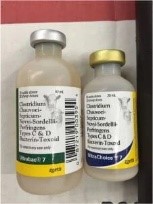Blackleg and Other Clostridial Diseases in Cattle
What is blackleg?


What are other clostridial diseases?
How are clostridial bacteria transmitted?
Clostridial bacteria are found in the soil virtually everywhere. In the presence of oxygen, the bacteria form spores that allow them to resist environmental changes and survive in the soil in a dormant state for years. Animals are infected by eating contaminated feed or pasture with clostridial spores. Animals that die from clostridial diseases can seed the environment with clostridial spores; therefore, these animal carcasses should be burned or buried. Blackleg and clostridial disease outbreaks are often associated with land excavation or flooding that causes large amounts of spores to resurface.
Clinical Signs
- Depressed
- Becomes lame with swelling of a muscle or group of muscles.
- Unable to stand.
- The skin will sometimes be discolored and may “crackle” when it is touched.
- Bloody froth from nose.
- Muscle tissue will contain dark areas, hence the name blackleg.
The disease develops over a short period of time (12 to 48 hours), and are often found dead without any prior signs of trouble.

Can blackleg be treated?

How can you prevent blackleg?
It is not possible to prevent clostridial bacteria from being present in the soil, but it is possible to vaccinate animals to prevent the occurrence of the disease. Clostridial vaccines are very effective if given to young, healthy animals in time for them to increase their immunity before being challenged by the disease.
- Calves should receive 2 doses of black leg vaccine. First being 2 months of age. A revaccination 3 to 4 weeks later according to product label directions.
- A booster vaccination every 12 months.
Remember:
- Read and follow the instructions on the label of the vaccine.
- Store the vaccine properly and administer it correctly.
- Initial primary and booster vaccination according to label directions.
- A single blackleg vaccination will not provide adequate protection.
- When calves are 3 to 4 months old, they become susceptible to the disease.
- Delaying vaccination until a calf is older can be inviting disaster.
